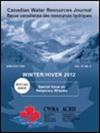Phosphorus dynamics in agricultural surface runoff at the edge of the field and in ditches during overbank flooding conditions in the Red River Valley
IF 1.7
4区 环境科学与生态学
Q3 WATER RESOURCES
引用次数: 1
Abstract
Abstract Agricultural fields in the Red River Valley of the Northern Great Plains are located on flat clay soils, often drained by shallow, roadside ditches that are not graded and lacking relief. These conditions can result in flow reversals and subsequent flooding of adjacent fields during large runoff events, which can mobilize phosphorus (P). Surface runoff from two agricultural fields and their adjacent ditches was monitored from 2015 to 2017 in southern Manitoba, Canada. Overbank flooding of fields adjacent to ditches was observed in 5 of 21 hydrologic events, and such events dominated annual runoff and P budgets (>83% of losses over the 3-year study period). Flooding events were often dominated by soluble P fractions (57–67%) relative to events where flooding was not observed (39–63%). Concentrations of soluble reactive P in water standing on fields increased with time during flooding events, suggesting that P was mobilized during such events; however, the source of the soluble reactive P is not clear. This study has highlighted temporal differences in hydrologic and biogeochemical interactions between fields and ditches and demonstrated the need for an improved understanding of mechanisms of P mobilization in the landscape, which has direct implications for predicting P mobility in agricultural watersheds.红河谷河岸洪水条件下农田边缘和沟渠农业地表径流磷动态
北部大平原红河谷的农田位于平坦的粘土上,通常由浅的路边沟渠排水,这些沟渠没有分级,缺乏浮雕。在大径流事件中,这些条件可能导致水流逆转和相邻农田随后的洪水,这可能会调动磷(P)。2015年至2017年,加拿大马尼托巴南部监测了两个农田及其相邻沟渠的地表径流。在21个水文事件中,有5个发生了沟渠附近农田的堤岸洪水,这些事件主导了年径流和磷预算(占3年研究期间损失的83%)。相对于未观察到淹水的事件(39-63%),淹水事件通常以可溶性P组分(57-67%)为主。在淹水期间,田间积水中可溶性活性磷浓度随时间增加,表明磷在淹水期间被动员;然而,可溶性活性磷的来源尚不清楚。该研究强调了农田和沟渠之间水文和生物地球化学相互作用的时间差异,并表明需要改进对景观中磷动员机制的理解,这对预测农业流域磷的流动具有直接意义。
本文章由计算机程序翻译,如有差异,请以英文原文为准。
求助全文
约1分钟内获得全文
求助全文
来源期刊

Canadian Water Resources Journal
WATER RESOURCES-
CiteScore
2.90
自引率
5.90%
发文量
17
审稿时长
>12 weeks
期刊介绍:
The Canadian Water Resources Journal accepts manuscripts in English or French and publishes abstracts in both official languages. Preference is given to manuscripts focusing on science and policy aspects of Canadian water management. Specifically, manuscripts should stimulate public awareness and understanding of Canada''s water resources, encourage recognition of the high priority of water as a resource, and provide new or increased knowledge on some aspect of Canada''s water.
The Canadian Water Resources Journal was first published in the fall of 1976 and it has grown in stature to be recognized as a quality and important publication in the water resources field.
 求助内容:
求助内容: 应助结果提醒方式:
应助结果提醒方式:


